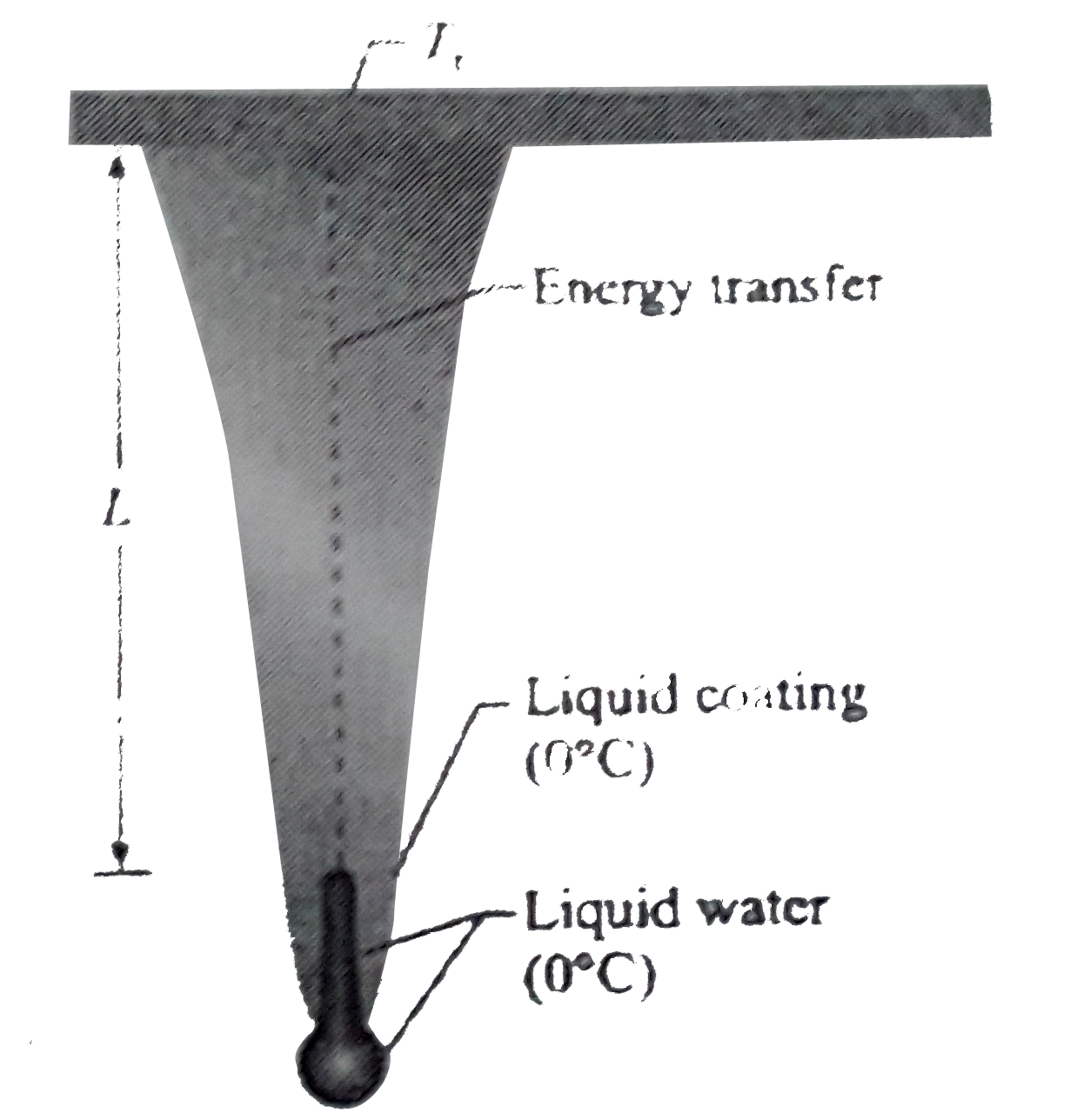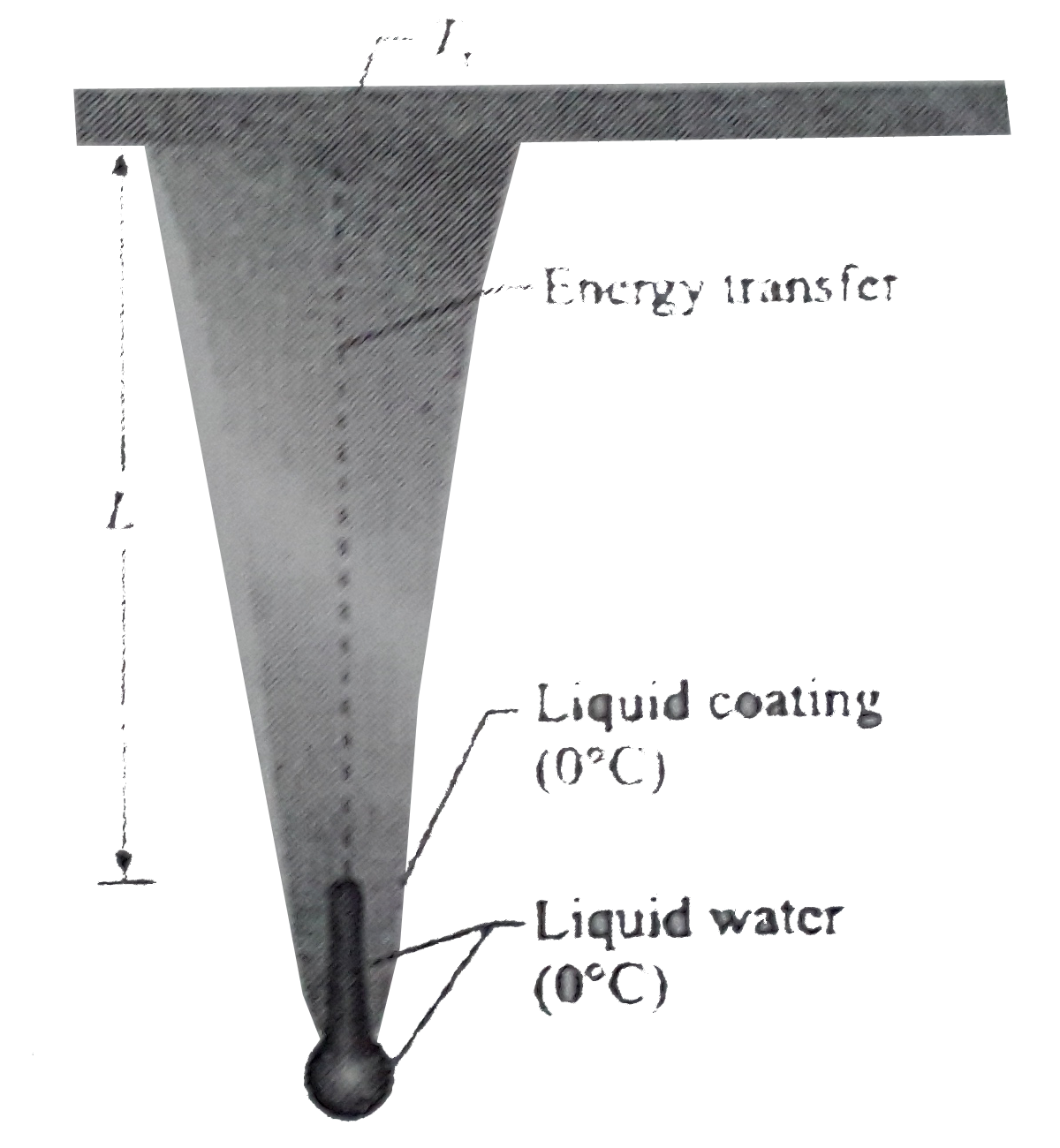Liquid water coats an active (growing) icicle and extends up a short, narrow tube along the central axis. Because the water-ice interface must have a temperature of 0∘C, the water in the tube cannot lose energy through the sides of the icicle or down through the tip because there is no temperature change in those directions . It can lose energy and freeze only by sending energy up(through distance L) to the top of the icicle, where the temperature Tr can be below 0∘C. Take L=0.10m and Tr=−5∘C.Assume that the central tube and the upward conduction path both have crosse-sectional area A=0.5m2. The thermal conductivity of ice is 0.40 W/m⋅K, latent heat of fusion is LF=4.0×105J/K and the density of liquid water is 1000 kg/m3.

The rate at which mass converted from liquid to ice at the top of the central tube is
7.5×10−3kg/s
2.5×10−5kg/s
5×10−3kg/s
5×10−5kg/s
The correct Answer is:B
Step by step video & image solution for Liquid water coats an active (growing) icicle and extends up a short, narrow tube along the central axis. Because the water-ice interface must have a temperature of 0^(@)C, the water in the tube cannot lose energy through the sides of the icicle or down through the tip because there is no temperature change in those directions . It can lose energy and freeze only by sending energy up(through distance L) to the top of the icicle, where the temperature T_(r) can be below 0^(@)C. Take L=0.10m and T_(r)=-5^(@)C.Assume that the central tube and the upward conduction path both have crosse-sectional area A=0.5m^(2). The thermal conductivity of ice is 0.40 W//mcdotK, latent heat of fusion is L_(F)=4.0xx10^(5) J//K and the density of liquid water is 1000 kg//m^(3). The rate at which mass converted from liquid to ice at the top of the central tube is by Physics experts to help you in doubts & scoring excellent marks in Class 11 exams.
Updated on:21/07/2023Topper's Solved these Questions
- TRANSMISSION OF HEATBOOK - CENGAGE PHYSICS ENGLISHCHAPTER - TRANSMISSION OF HEATEXERCISE - Fill in the blanks type
6 Videos
- TRANSMISSION OF HEATBOOK - CENGAGE PHYSICS ENGLISHCHAPTER - TRANSMISSION OF HEATEXERCISE - Single Corrct Answer
7 Videos
- TRANSMISSION OF HEATBOOK - CENGAGE PHYSICS ENGLISHCHAPTER - TRANSMISSION OF HEATEXERCISE - Multiple Correct Answer Type
2 Videos
- THERMODYNAMICSBOOK - CENGAGE PHYSICS ENGLISHCHAPTER - THERMODYNAMICSEXERCISE - 24
1 Videos
- TRAVELLING WAVESBOOK - CENGAGE PHYSICS ENGLISHCHAPTER - TRAVELLING WAVESEXERCISE - Integer
9 Videos
Similar Questions
Liquid water coats an active (growing) icicle and extends up a short, narrow tube along the central axis. Because the water-ice interface must have a temperature of 0∘C, the water in the tube cannot lose energy through the sides of the icicle or down through the tip because there is no temperature change in those directions . It can lose energy and freeze only by sending energy up(through distance L) to the top of the icicle, where the temperature Tr can be below 0∘C. Take L=0.10m and Tr=−5∘C.Assume that the central tube and the upward conduction path both have crosse-sectional area A=0.5m2. The thermal conductivity of ice is 0.40 W/m⋅K, latent heat of fusion is LF=4.0×105J/K and the density of liquid water is 1000 kg/m3.

At what rate does the top of the tube move downward because of water freezing there?
View SolutionHeat required to raise the temperature of one gram of water through 1∘C is
View Solution
Knowledge Check
At high altitudes , water boils at a lower temperature because
Athe atmospheric pressure is high at high altitudesBthe viscosity of water is reduced at altitudesCthe atmospheric pressure is low at high altitudesDthe surface tension of water is reduced at high altitudes .The water is transported up to the leaves through
Acortex cellsBparenchymaCxylemDphloem
The pollen tubes grow through the solid style by separating their cell through the secretion of
View SolutionOn heating the liquid, do the particles gain or lose energy.
View SolutionThe velocity of liquid flowing through a tube at certain distance from the axis of tube
View SolutionThe water flowing through the same tube having two different cross section areas has different flow rates .
View SolutionWater can not diffuse through
View SolutionBubbles of air can rise up through a liquid Why?
View Solution
